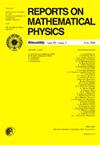5型kadomtsev-petviashvili方程孤子的完全非负普法性
IF 1.2
4区 物理与天体物理
Q3 PHYSICS, MATHEMATICAL
引用次数: 0
摘要
在正交型变换群下,对Kadomtsev-Petviashvili (KP)层次进行约简,得到了b型Kadomtsev-Petviashvili方程(BKP)。斜Schur的Q函数可以用来构造BKP方程中孤子的t函数。然后通过斜Schur的Q函数定义完全非负Pfaffian,得到BKP方程的非奇异线孤子解。研究了完全非阴性的Pfaffians。线孤子在近场区域相互作用形成网状结构,它们在孤子图上的共振可以用完全非负法菲子来研究。本文章由计算机程序翻译,如有差异,请以英文原文为准。
TOTALLY NONNEGATIVE PFAFFIAN FOR SOLITONS IN 5-TYPE KADOMTSEV–PETVIASHVILI EQUATION
The B-type Kadomtsev–Petviashvili equation (BKP) is obtained from the reduction of Kadomtsev–Petviashvili (KP) hierarchy under the orthogonal type transformation group. The skew Schur's Q functions can be used to construct the t-functions of solitons in the BKP equation. Then the totally nonnegative Pfaffian can be defined via the skew Schur's Q functions to obtain nonsingular line-solitons solution in the BKP equation. The totally nonnegative Pfaffians are investigated. The line solitons interact to form web-like structure in the near field region and their resonances appearing in soliton graph could be investigated by the totally nonnegative Pfaffians.
求助全文
通过发布文献求助,成功后即可免费获取论文全文。
去求助
来源期刊

Reports on Mathematical Physics
物理-物理:数学物理
CiteScore
1.80
自引率
0.00%
发文量
40
审稿时长
6 months
期刊介绍:
Reports on Mathematical Physics publish papers in theoretical physics which present a rigorous mathematical approach to problems of quantum and classical mechanics and field theories, relativity and gravitation, statistical physics, thermodynamics, mathematical foundations of physical theories, etc. Preferred are papers using modern methods of functional analysis, probability theory, differential geometry, algebra and mathematical logic. Papers without direct connection with physics will not be accepted. Manuscripts should be concise, but possibly complete in presentation and discussion, to be comprehensible not only for mathematicians, but also for mathematically oriented theoretical physicists. All papers should describe original work and be written in English.
 求助内容:
求助内容: 应助结果提醒方式:
应助结果提醒方式:


